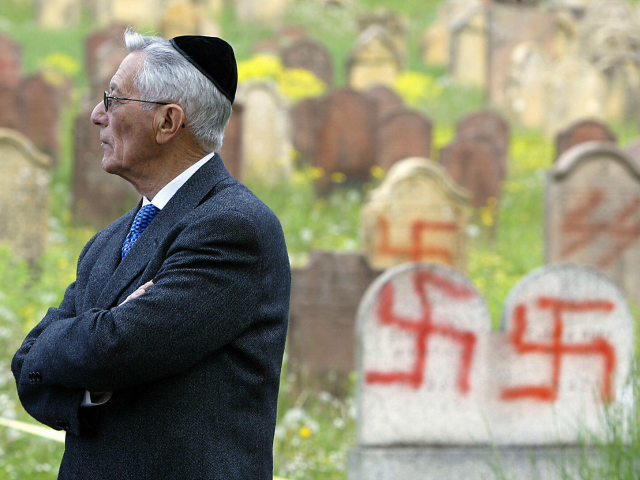AFP – When Alain Benhamou walked into his apartment near Paris in July 2015 and saw the words “dirty Jew” scrawled on the wall, he knew it was time to leave.
It was his second such break-in in less than three months and the 71-year-old no longer felt welcome in Bondy, a Parisian suburb he had called home for more than 40 years.
“Until the years 2000-2005, the town was nice and quiet, with 250 to 300 Jewish families and synagogues full on the Sabbath,” Benhamou says.
“Now, only about a hundred Jewish families remain.”
Benhamou is part of a growing number of French Jews who have effectively become internal refugees, fleeing insecurity and seeking protection in numbers in an atmosphere they say is increasingly hostile, and often expressed in relation to conflict in the Middle East.
He moved a few miles south to Villemomble, where there is a larger and more established Jewish community.
But others have fled France altogether.
A record 8,000 or so French Jews moved to Israel in 2015 alone, according to Israeli figures, in the year that a jihadist gunman linked to the Charlie Hebdo newspaper attackers killed four Jews in a kosher supermarket.
France has the largest Jewish population in Europe, estimated at 500,000 to 600,000 people.
Half of them live in the Paris region but their numbers have declined steadily over the past 15 years, researchers say.
Jerome Fourquet of polling firm IFOP says the change started around 2000 following a fresh surge of violence between Israel and the Palestinians, known as the second intifada.
With France also home to Europe’s largest Muslim community, which counts around five million members, the bloodshed in the Middle East unleashed a wave of unrest, particularly in the Paris region which saw a surge in anti-Semitic acts and threats, he says.
– A disappearing community –
Benhamou still lives within the sprawling Seine-Saint-Denis department that sits northeast of the capital and combines run-down immigrant ghettos with trendy new gentrified business districts.
In the last 15 years, it has gone from being one of France’s most densely-populated Jewish areas to what the community now considers “one of the lost territories of the Republic”.
“The Jewish community is expected to disappear from here,” Benhamou says.
In nearby Raincy, Rabbi Moshe Lewin shares Benhamou’s pessimism, fearing he could be one of the last Jewish leaders in Seine-Saint-Denis.
“What upsets me is that in some areas of France, Jews can no longer live peacefully, and that just five minutes from my home, some are forced to hide their kippas (skullcaps) or their Star of David,” he admits.
Even areas with a strong Jewish population, such as Sarcelles to the north, still have major problems.
Francois Pupponi, the Socialist mayor of Sarcelles, says many Jewish residents come to him for help with stories of being assaulted or having swastikas daubed on walls outside their homes.
Some have been caught in “extremely violent situations” that in some cases required families to be “urgently rehoused”, says Pupponi.
He became aware of “a phenomenon of internal migration” about five or six years ago, which he says “is getting worse”.
– ‘Little Jerusalem’ –
Nonetheless, Jews from elsewhere still see Sarcelles as a relative haven. New arrivals now find “a much stronger police and institutional presence” than before and “they can live out their Judaism here in safety,” says Pupponi.
Among the newcomers is Eva Sandler, the widow of Rabbi Jonathan Sandler who was killed in an Islamist shooting attack on a Jewish school in Toulouse in 2012.
Other areas have also seen an influx of new arrivals.
Many say the heart of the Jewish community is no longer Sarcelles but in Paris’ western 17th district which has now taken over the moniker of “Little Jerusalem”.
Now in his 60s, Robert moved there a decade ago with the northwestern neighbourhood’s Jewish population reflected in the wealth of eateries selling kosher foods, from specialised sweet shops to sushi bars.
“Because anti-Semitism is growing, we try and stick together to avoid it,” admits Robert, who did not want to give his surname.
Community group the Consistoire Israelite has taken note of the shift in centre of gravity and is currently building a Centre for European Judaism in the neighbourhood which is slated to open next year.
– ‘Becoming less visible’ –
But across the city in the eastern neighbourhood of Saint-Mande, the wind appears to have changed.
Formerly known for its large Jewish community with two synagogues and a community day care centre, the district has been badly hit by the deadly hostage-taking at the kosher supermarket in January 2015.
“There were about 12 or 13 Sainte-Mande residents among (the hostages),” recalls local mayor Patrick Beaudouin.
“It had a huge psychological impact.”
He said dozens of families had since left the area, deciding it was best “to spread out, to be less visible”.
For now, most French Jews have preferred to cluster in towns and neighbourhoods where they know a large Jewish community already exists.
But that decision to flock together brings about its own problems.
“We are creating ghettos,” Pupponi says. “We are aware of that.”
The solution, he says, would be “to achieve social and ethnic integration in all neighbourhoods.”
“But France has been trying to achieve this for the past 30 years and it still hasn’t happened.”

COMMENTS
Please let us know if you're having issues with commenting.